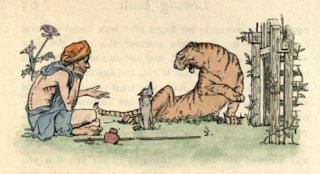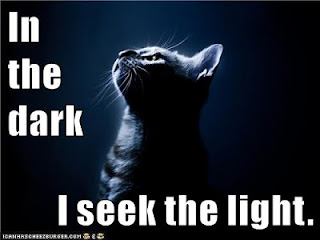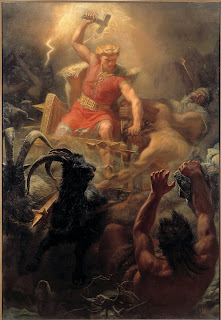Reading Notes: Intro Anthology
A Tiger, a Brahman, and a Jackal (Illustration by John Batten)
Origin Stories
o
I like how direct the introduction is.
Characters just are: “a wise man, who had power over all things”
o
Interesting use of dialect to move through the
plot. Mostly quotations with small bits of exposition.
o
Again simple statements to spark the story in
focus
o
I like the level of detail in this story, it
gives a good feel to reading it.
o
Broken into sections that begin with Now or Then
often, creating a sense of rhythm
o
Almost broken into stanza or verse style. Seems
to have come from spoken mythology
The Supernatural
o
“ By and By” seems to be unique to North
American stories
o
Common theme in The Hare story as well: using
request for food as a means of testing central character and revealing their
morality/ethics
o
Interesting use of two episodes, more commonly
see three smaller portions of the story or 5 with intro and conclusion
§
Feels unresolved
o
Like the use of “darkness helps the ghost
(representative of darkness, failure, self-doubt, holding back, and other personal
struggles; because if he defeats him he will complete his mission of defeating
his enemy) and light helps him win. Representative of that classic “Darkest
before the dawn” theme.
Tricksters
The Tiger, The Brahman, and the Jackal, John D.
Batten
o
Again intro is very direct, use of dialogue to develop
plot, more exposition
o
Interesting setup of plot; tiger tricks brahman
who then goes to three essentially “judgements” on himself
o
Main use of dialogue to move plot when
description would be hard
o
Plot twist at the end as the jackal ends up
being the real trickster better than the trickster. Classic brain over brawn
story as Tiger is much stronger but more arrogant
Bibliography
Man in the Moon, Katherine Neville Fleeson
The Hare that was not Afraid to Die, Marie Shedlock
The Indian Who Wrestled with a Ghost, Katharine Berry Judson
The Tiger, The Brahman, and the Jackal, John D. Batten




Comments
Post a Comment